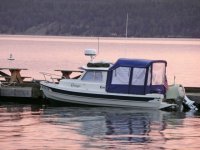There have been many threads on the noise generated in the cabin on the C-Dory’s without a cabin bulkhead. I have been trying different things to lessen the engine noise inside the cabin. The foam rubber you see on the engine has made a big difference.

I now have to figure out a way of building something that will not interfere with either engine when they are turned or raised. It has to be mounted to the engine and easy to remove. I would like something that can be layered and shaped around the engine but not against it, like lead flashing but much lighter.
Building something really is not the problem, it is, I would like something besides thick foam for the insulation and would prefer something that could be layered in the enclosure.
Anybody know of a good sound insulation material that is light and thin?
________
Dave

I now have to figure out a way of building something that will not interfere with either engine when they are turned or raised. It has to be mounted to the engine and easy to remove. I would like something that can be layered and shaped around the engine but not against it, like lead flashing but much lighter.
Building something really is not the problem, it is, I would like something besides thick foam for the insulation and would prefer something that could be layered in the enclosure.
Anybody know of a good sound insulation material that is light and thin?
________
Dave

